Hike at a Glance
Max elevation: 709m
Min elevation: 354m
Total Ascent: 362m
Important info
This trail is extremely challenging, featuring a very rough surface and steep hills, requiring significant rock hopping and scrambling. Directional signage is limited or nonexistent. It is suitable only for highly experienced bushwalkers with advanced navigation skills, emergency first aid knowledge, and a high level of fitness.
Hike overview
The Talyuberlup Walk Trail is a steep and challenging 2.6-kilometre return hike leading to a rocky peak that offers exceptional views and an array of wildflowers. This grade 5 hike, located in Stirling Range National Park, Western Australia, typically takes around 1.5 hours to complete and features a maze of gullies, caves, and rocky outcrops for exploration.
Talyuberlup is the most dramatic rock peak in the Stirling Ranges, rising to 783 metres. Its jagged, pinnacled summit resembles a castle, providing a striking visual backdrop. The trail begins by winding through low woodland before steeply ascending a gully, then progressing towards the base of the cliffs. Hikers will navigate along the cliff line and enter a large cave that tunnels beneath the summit, eventually emerging onto the peak of Talyuberlup. The ascent covers a vertical distance of 600 metres over 1.3 kilometres, and caution is advised as the path can become treacherous when wet.
Tips
- Standard park entry fees apply for Stirling Range National Park.
- The Stirling Range experiences unpredictable weather. Hikers should be aware of the possibility of sudden temperature drops, rain, or hail.
- Hikers planning to venture off marked trails, abseil, or rock climb should register at the shelter across from the Bluff Knoll Road entry station picnic area. This helps park rangers be aware of your location in case of emergencies.
Gallery
Got some great shots from this hike? Upload your photos here to inspire others and show off the beauty of the trail!
Click to view form >>
Submitting your photos doesn’t mean you lose ownership. You can be credited for your contributions, and you can request removal at any time.
Content use
Please don’t copy GPX files or content from this site to AllTrails or other platforms. Each trail has been personally mapped, documented, and refined to support Australia’s bushwalking and hiking community. While some details come from land managers, every listing reflects significant personal effort. This is a free, community-driven initiative—your respect helps keep it that way.
Walk map and GPX file
Max elevation: 709 m
Min elevation: 354 m
Total climbing: 362 m
Total descent: -362 m
Getting there
Getting to the trailhead: Stirling Range National Park.
The trailhead is located on Stirling Range Drive within Stirling Range National Park, approximately 430 kilometres (about a five-hour drive) south of Perth.
Closest towns to this walk: Albany, Bluff Knoll, Borden, Forest Hill, Frankland, Frankland River, Gnowangerup, Katanning, Kendenup, Kojonup, Mount Barker, Mt Barker, Narrikup, Ongerup, Porongurup, Ravensthorpe
About the region
Stirling Range National Park is home to the only significant mountain range in the southern region of Western Australia, with peaks exceeding 1,000 metres above sea level. This unique landscape provides a challenging and spectacular hiking experience. The Aboriginal name for the range, Koi Kyenunu-ruff, translates to ‘mist rolling around the mountains,’ a phenomenon that frequently occurs in the area.
During spring and early summer, the ranges come alive with an abundance of wildflowers and birdlife, which can be observed from various hiking trails, lookouts, and picnic areas throughout the park. For those who prefer not to hike, a 42-kilometre scenic drive on mostly unsealed, graded roads winds through the heart of the park, offering numerous stops along the way.
Accommodation options include the Stirling Range Retreat and the Mount Trio Bush Camping and Caravan Park, both situated on the northern boundary of the park. Bluff Knoll, known as Bular Mial, holds cultural significance for the Minang and Goreng people, and informative signage at the Eastern Lookout shares valuable insights and stories about the area.
The peaks of the Stirling Range are prone to rapid and unpredictable weather changes, so hikers must be prepared for sudden cool changes that can bring temperature drops, rain, or hail. All visitors are strongly advised to avoid entering the bush or using footpaths during days of extreme fire danger. Those planning to hike off marked trails, as well as those intending to abseil or rock climb, should register their details at the shelter located in the picnic area across from the Bluff Knoll Road entry station. Registration is not required for those hiking established trails.
Recognition and acknowledgement are given to the Goreng and Menang people as the Traditional Owners of Stirling Range National Park.
Similar walks nearby
Looking for more walks in or near Stirling Range National Park? Try these trails with a similar difficulty grade.
Track grade
Grade 5 (Difficult) - Walks for the Most Experienced: Grade 5 represents the most challenging walking tracks on the AWTGS. These are only recommended for very experienced and fit walkers with specialised skills, including navigation and emergency first aid. Tracks are likely to be very rough, very steep, and unmarked. Walks may be more than 20 kilometers. These challenging walks demand a high level of fitness and experience to navigate difficult terrain, significant elevation changes, and potentially unformed paths.
Explore safe
Plan ahead and hike safely! Carry enough water, pack layers for changing conditions, and bring safety gear like a torch, PLB, and reliable communication device. Check official sources for trail updates, closures, and access requirements, and review local weather and bushfire advice. Most importantly, share your plans with someone before you go. Being prepared makes for a safer and more enjoyable hike! Stay Safe, Explore More, and Always #ExploreSafe.
Packing checklists
What you carry in your pack depends on factors like weather, terrain, and your adventure type. Not sure what to bring? My free planning, food, and packing checklists are a great starting point, covering day hikes, overnight trips, and multi-day adventures. Use them to customise your kit and always prioritise safety.
Let someone know
Before heading out, take a moment to fill out your trip intentions form. It’s a quick way to share your hike details with family or friends. If something goes wrong, they can notify emergency services, ensuring a faster response and peace of mind. Stay safe and enjoy your adventure
Suggest an edit
Spotted a change on this trail? Maybe there are new features, the route has shifted, or the trail is permanently closed. Whatever the update, I’d love your input. Your feedback helps fellow hikers stay informed and ensures that our trail info stays fresh and reliable.
Acknowledgement of Country
Trail Hiking Australia acknowledges the Traditional Owners of the lands on which we hike and pay respects to their Elders, past and present, and we acknowledge the First Nations people of other communities who may be here today.






